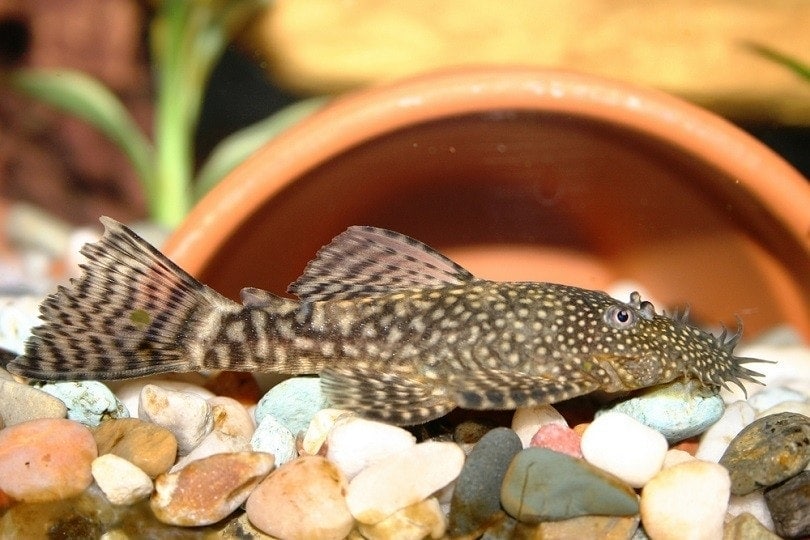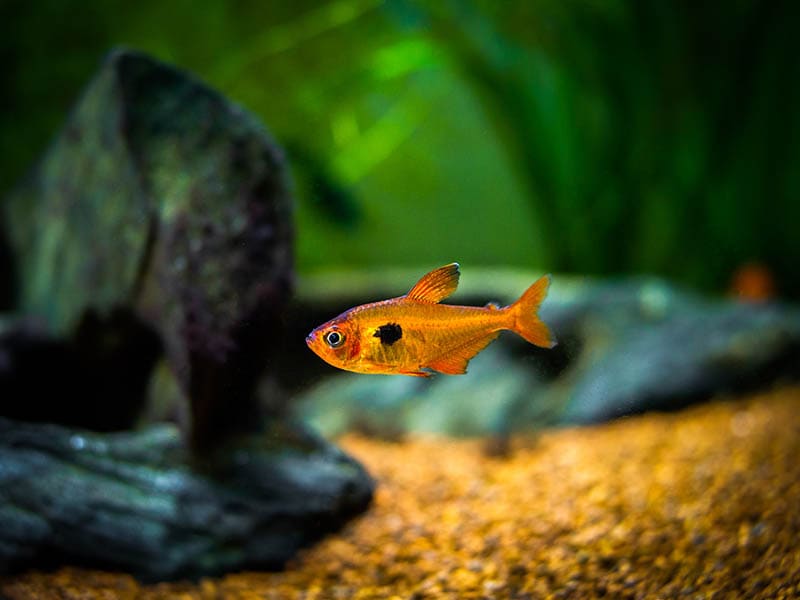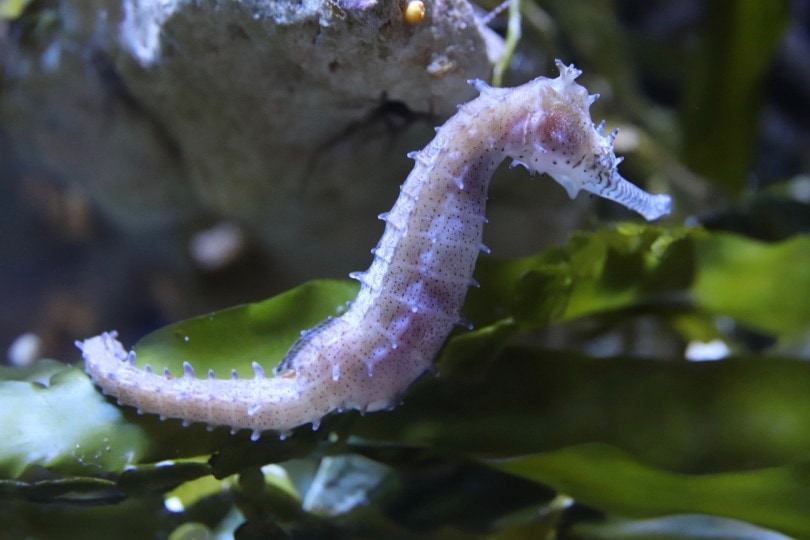Glass Catfish: Care Guide, Varieties & Lifespan (With Pictures)
Updated on
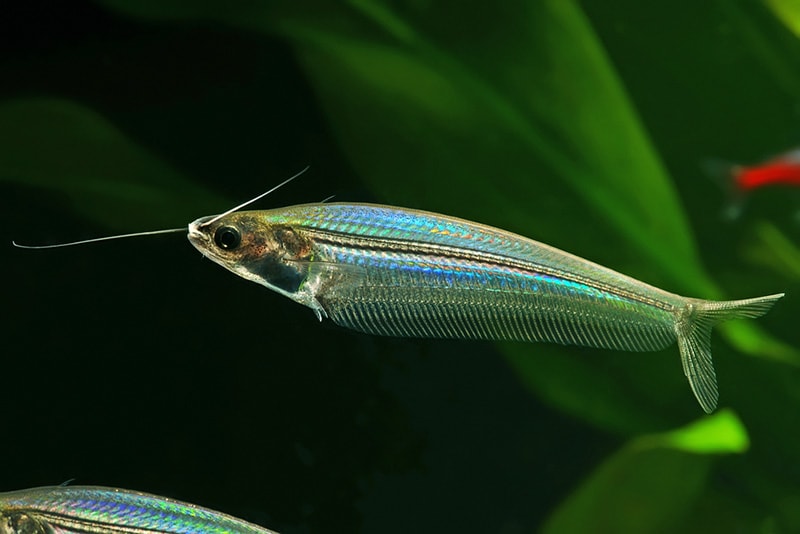
Glass or Phantom Catfish are unique freshwater fish with distinctive transparent bodies. These fish make an interesting addition to aquariums, although they are better suited for experienced fish keepers.
Glass Catfish don’t disappoint when it comes to their behavior and appearance. They are medium-sized fish that lack color pigmentation, which makes them resemble glass. Their transparent bodies might not be colorful, but their uniqueness makes them a popular choice for many fish keepers looking to liven up their aquarium.
Keeping Glass Catfish healthy can be tricky since they have specific care requirements that need to be met. We have created this article to give you all the info you need to ensure that your Glass Catfish can thrive in your aquarium.
Quick Facts about Glass Catfish
| Species Name: | Kryptopterus vitreolus |
| Family: | Siluridae |
| Care Level: | Intermediate |
| Temperature: | 75°F to 80°F |
| Temperament: | Peaceful and social |
| Color Form: | Transparent |
| Lifespan: | 6 to 8 years |
| Size: | 2.5 to 6.5 inches |
| Diet: | Omnivore |
| Minimum Tank Size: | 30 gallons |
| Tank Set-Up: | Freshwater, tropical, planted |
| Compatibility: | Community aquariums |

Glass Catfish Overview
There are four main species of Glass Catfish belonging to the Kryptopterus genus. This includes K. vitreolus, K. bicirrhis, K. piperatus, and K. minor. All these species have transparency on their bodies which is why we refer to them as “Glass” Catfish. The K. vitreolus species is now considered the most popular species of Glass Catfish, and they were first mistaken to be K. bicirrhis. The latter species is also considered rare in the aquarium trade. There is a lot of confusion between the different species since they have similar common names. However, the K. vitreolus is typically referred to as the Asian Glass Catfish.
Glass Catfish originate from freshwater habitats throughout Southeast Asia. The K. vitreolus can be found in Thailand where they inhabit slow-moving waters with a muddy substrate. Whereas the K. piperatus and K. minor can be found in rivers in Indonesia, such as the Lembang River. Glass Catfish prefer habitats that are still with few strong currents.
They are bottom feeders, so they prefer to swim along the substrate in aquariums rather than near the surface. Although Glass Catfish have small barbels surrounding their mouths, they are not a type of suckerfish.
In the wild, Glass Catfish will stay in large groups and forage amongst the substrate and vegetation for food. Keeping them together in groups encourages Glass Catfish to display similar behavior patterns like they would in the wild.
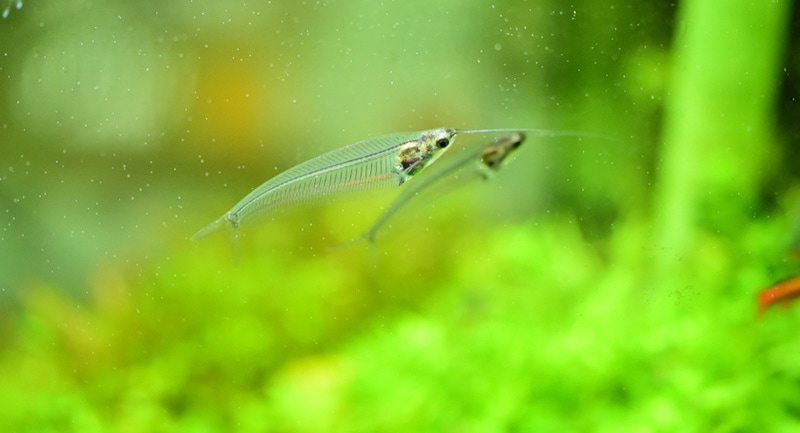
How Much Do Glass Catfish Cost?
Due to the Glass Catfish’s unique appearance, they might be more costly than other fish. Most pet stores usually sell Glass Catfish for $10 to $30. Their total price can vary depending on their size, health, and species. The K. minor and K. piperatus species are usually higher priced than the K. vitreolus. Regardless, you are unlikely to spend more than $30 for one Glass Catfish.
Typical Behavior & Temperament
Glass Catfish are social and peaceful fish that show few signs of aggression or territorial behavior. This is one of the main reasons they are often kept in community aquariums. They are active fish that form schools that prefer the bottom or middle part of aquariums. Healthy and happy Glass Catfish won’t hide very often, so you are guaranteed to have a clear view of their swimming behaviors.

Appearance & Varieties
Each species of Glass Catfish looks alike, but there are subtle differences between them. The K. minor seems to be the smallest species reaching a size of 2.5 inches. Whereas the K. bicirrhis is the largest at 6.5 inches in size. The K. vitreolus only reaches a size of 3 inches in captivity. Only the K. vitreolus, K. minor, and K. piperatus species have an entirely transparent body. The K. bicirrhis species only has a bit of transparency behind their heads.
You can visibly see their skeleton and sometimes even their internal organs through their bodies. Glass Catfish get their transparency from a lack of pigmentation. Like many other species of catfish, Glass Catfish do not have scales. At first glance, it might appear as if Glass Catfish have no fins. Their most visible features are their heads and skeletons. Glass Catfish have a hidden anal fin that is clear and often tucked away. They have a forked caudal fin, and a pair of pectoral fins, but no dorsal fin.
You can easily spot Glass Catfish in an aquarium by their transparent bodies and reflective skeletons. A pair of barbels can be seen on either side of their small mouths.
How to Take Care of Glass Catfish
Habitat, Tank Conditions & Setup
Glass Catfish requires a minimum tank size of 30 gallons. This sized fish tank can comfortably support five to six glass catfish. However, the K. bicirrhis species needs a slightly larger fish tank due to their size. If you keep glass fish in community aquariums, the fish tank will need to be larger than 40 gallons or more. This ensures that each fish has enough space in the aquarium without becoming overcrowded.
Water Quality & Conditions
Glass Catfish are tropical fish that should be kept in freshwater aquariums with a heater. Their aquarium needs to be fully cycled and have no traces of ammonia and nitrite. Glass Catfish are sensitive and a slight change in water parameters can stress them out. They are usually the first fish to die during an ammonia spike.

| Temperature | 75 to 80 degrees Fahrenheit |
| pH range | 6 to 7.5 |
| Water hardness | 8 to 10 dGH |
| Ammonia | 0 ppm |
| Nitrite | 0 ppm |
| Nitrate | Below 15 ppm |
Substrate
Glass Catfish prefer a sandy or muddy substrate which they experience in their wild habitats. Sandy substrates are also recommended if you grow live plants in your Glass Catfish aquarium. Alternatively, you can use a basic substrate like gravel if it is your preference.
Plants
Plants are highly recommended for Glass Catfish since it offers them a more naturalistic environment. Glass Catfish benefit from having live plants for improved water quality, shelter, and spawning material. They aren’t fussy about the types of plants in the aquarium. They enjoy various freshwater plants like Amazon Sword, Anubia, Java Moss, and Vallisneria. Foreground or runner plants are generally preferred for these catfish.

Lighting
If you grow live plants in the aquarium or want to see your Glass Catfish clearly, light is necessary. Glass Catfish prefer low to moderate overhead lighting, which should be turned off at night. Avoid keeping the lights on for more than 10 hours a day, as too much lighting may contribute to algae growth.
Filtration
Your Glass Catfish aquarium should contain a filtration system. Their filter should aerate the water without producing a strong current. Sponge filters are usually preferred for Glass Catfish. They are relatively inexpensive and great at filtering and aerating the water without much of a current.
Are Glass Catfish Good Tank Mates?
When kept with other compatible fish or invertebrates, Glass Catfish can make good tank mates. Some of the best Glass Catfish tank mates are other peaceful and tropical fish that are similar in size. Tetras, Guppies, Kuhli Loaches, snails, and Corydoras make ideal tank mates for Glass Catfish. You should never keep Glass Catfish and large or aggressive fish together. This is a disaster waiting to happen, as Glass Catfish can get eaten or injured.
Furthermore, Glass Catfish are tropical fish, so they don’t pair well with goldfish, koi, or other cold-water fish. Shrimp could be a potential tank mate for glass fish if there are plenty of hiding spots. Glass Catfish will occasionally prey on shrimp and small snails if they can find them.

What to Feed Your Glass Catfish
Glass Catfish are omnivores, and their diet should replicate foods they would naturally eat in the wild. Glass Catfish enjoy a varied diet consisting of live foods, flakes or pellets, and supplements.
In the wild, Glass Catfish primarily feed on zooplankton, insect larvae, smaller fish, and invertebrates. They lean more towards being a carnivore in the wild but can be fed an omnivorous diet in captivity. A high-quality pellet or flake food should be your Glass Catfish’s main source of nutrition. These foods contain all the nutrients your Glass Catfish needs to stay healthy. Live or frozen foods such as bloodworms, shrimp, and brine shrimp can be offered to Glass Catfish up to four times per week.
Keeping Your Glass Catfish Healthy
Just like glass, the Glass Catfish is delicate. They require specific conditions to thrive in aquariums and they are sensitive to environmental changes.
- Keep them in groups: Glass Catfish should never be housed alone or in pairs. Instead, they should be kept in groups of five or more. They are social fish that form schools of their species. They rely on each other for safety and social interactions.
- Cycle their aquarium first: Glass Catfish do not tolerate sudden changes in water parameters. Their aquarium should undergo the nitrogen cycle before they are added in. This ensures that the ammonia and nitrite can be converted to nitrates, which is not harmful to Glass Catfish at low levels.
- Keep them in planted aquariums: Planted aquarium setups are highly recommended for glass catfish. They seem to thrive in heavily planted tanks with sandy substrates.
- Keep the water filtered and heated: A heater is an important addition to Glass Catfish aquariums. The heater will keep the water within their ideal temperature range and prevent temperature fluctuations.
- Consider their tank mates carefully: Glass Catfish should only be kept with tank mates that are peaceful and small. Their tank mates should require similar water parameters to Glass Catfish, otherwise, they will be incompatible.
Breeding
It can be challenging to breed Glass Catfish, and there’s no specific method that breeders follow. Glass Catfish are egg layers and will deposit their eggs over plants and substrate in the tank. There are slight differences between the males and females. Male Glass Catfish usually have a slender body with a more defined triangular head. In females, their bodies are slightly rounder with less defined anal fins.
To encourage Glass Catfish to spawn, you will need to gradually increase the temperature to around 80 to 86 degrees Fahrenheit. Good water quality and frequent water changes can be used to trigger spawning behavior in Glass Catfish.

 Are Glass Catfish Suitable for Your Aquarium?
Are Glass Catfish Suitable for Your Aquarium?
Glass Catfish are delicate fish that will struggle to thrive in the wrong aquarium conditions. They require a spacious tank that can support groups of five or more, generally around 30 gallons in size. They need a heater and filter to keep the water moving and at a comfortable temperature. A heavily planted aquarium is a top choice for these fish. Live plants not only look good, but they also benefit Glass Catfish by making them feel more secure in an aquarium. When kept alongside peaceful fish like Tetras, Glass Catfish can thrive in community aquariums.
If your Glass Catfish has everything they need to thrive in an aquarium, you can expect them to live for around 8 years.
Featured Image Credit: Grigorev Mikhail, Shutterstock
